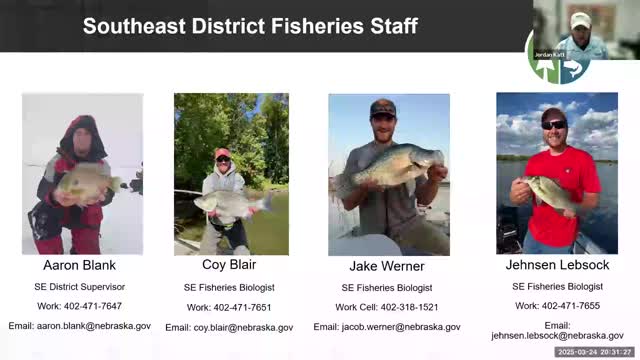Fishery officials plan Shadow Lake catfish and blue cat stockings this year
May 23, 2025 | Nebraska Game and Parks Commission (NGPC), State Agencies, Organizations, Executive, Nebraska
This article was created by AI summarizing key points discussed. AI makes mistakes, so for full details and context, please refer to the video of the full meeting. Please report any errors so we can fix them. Report an error »

In a recent Nebraska Southeast District Fisheries Meeting, the future of local fisheries took center stage, particularly focusing on Shadow Lake and the introduction of blue catfish across the district. As attendees gathered, the atmosphere buzzed with anticipation about the health and management of these vital aquatic resources.
The discussion began with Shadow Lake, which has not seen recent catfish stockings but is set to receive channel catfish this year. Fisheries experts revealed that Shadow Lake has been managed as a low-density fishery, and plans are in place to shift to a 3 to 5-year stocking schedule to maintain its fish population. This proactive approach aims to ensure the lake remains a viable habitat for anglers and wildlife alike.
Turning to blue catfish, a species that has garnered attention for its potential benefits, the meeting highlighted the challenges of sourcing these fish. Currently, Nebraska fisheries rely on trades with other states, primarily Missouri and Arkansas, to obtain blue catfish brood stock. The advantage of sourcing from southern states is significant; these fish spawn earlier, allowing hatcheries to grow them larger before stocking. This is crucial, as blue catfish are known to struggle with survival in hatchery conditions, particularly during winter months.
Past experiences with blue catfish stockings have shown promising results. For instance, a successful year class from Pawnee Lake, where fish were stocked at 8 to 10 inches, demonstrated remarkable growth and survival rates. In contrast, smaller fish stocked at 4 to 5 inches from Missouri had less favorable outcomes. The recent shift to Arkansas-sourced fish appears to be yielding positive results, with more smaller blue catfish being observed in samples, indicating that these efforts may be bolstering local populations.
Additionally, the meeting touched on the ongoing stocking of smaller blue catfish in Zarenski Lake, although no small blue catfish have yet been detected there. Fisheries officials plan to evaluate this further in the coming summer, hoping to see signs of a thriving population.
As the meeting concluded, the discussions underscored a commitment to enhancing Nebraska's fisheries through strategic stocking and management practices. The collaborative efforts of fisheries biologists and the community aim to ensure that local waters remain vibrant ecosystems for both fish and anglers, fostering a sustainable future for Nebraska's aquatic resources.
The discussion began with Shadow Lake, which has not seen recent catfish stockings but is set to receive channel catfish this year. Fisheries experts revealed that Shadow Lake has been managed as a low-density fishery, and plans are in place to shift to a 3 to 5-year stocking schedule to maintain its fish population. This proactive approach aims to ensure the lake remains a viable habitat for anglers and wildlife alike.
Turning to blue catfish, a species that has garnered attention for its potential benefits, the meeting highlighted the challenges of sourcing these fish. Currently, Nebraska fisheries rely on trades with other states, primarily Missouri and Arkansas, to obtain blue catfish brood stock. The advantage of sourcing from southern states is significant; these fish spawn earlier, allowing hatcheries to grow them larger before stocking. This is crucial, as blue catfish are known to struggle with survival in hatchery conditions, particularly during winter months.
Past experiences with blue catfish stockings have shown promising results. For instance, a successful year class from Pawnee Lake, where fish were stocked at 8 to 10 inches, demonstrated remarkable growth and survival rates. In contrast, smaller fish stocked at 4 to 5 inches from Missouri had less favorable outcomes. The recent shift to Arkansas-sourced fish appears to be yielding positive results, with more smaller blue catfish being observed in samples, indicating that these efforts may be bolstering local populations.
Additionally, the meeting touched on the ongoing stocking of smaller blue catfish in Zarenski Lake, although no small blue catfish have yet been detected there. Fisheries officials plan to evaluate this further in the coming summer, hoping to see signs of a thriving population.
As the meeting concluded, the discussions underscored a commitment to enhancing Nebraska's fisheries through strategic stocking and management practices. The collaborative efforts of fisheries biologists and the community aim to ensure that local waters remain vibrant ecosystems for both fish and anglers, fostering a sustainable future for Nebraska's aquatic resources.
View full meeting
This article is based on a recent meeting—watch the full video and explore the complete transcript for deeper insights into the discussion.
View full meeting
